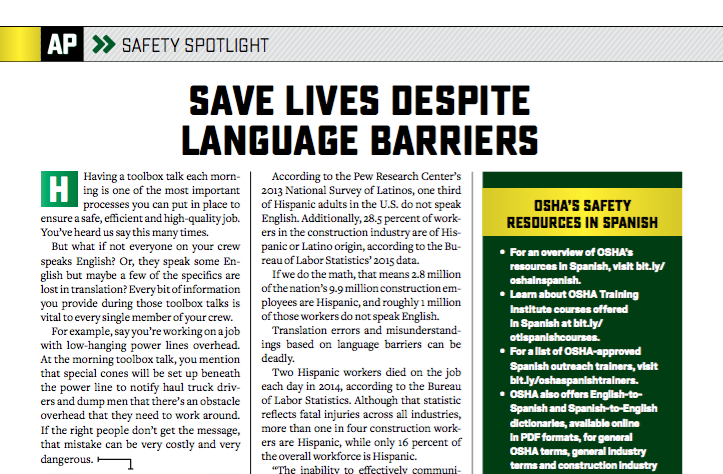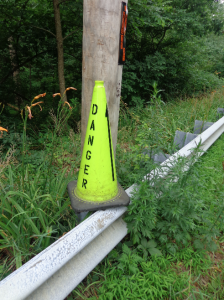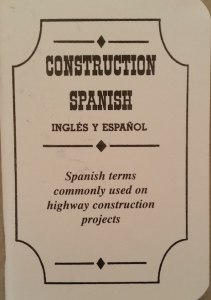Save Lives Despite Language Barriers
BY AsphaltPro Staff

Having a toolbox talk each morning is one of the most important processes you can put in place to ensure a safe, efficient and high-quality job. You’ve heard us say this many times.
But what if not everyone on your crew speaks English? Or, they speak some English but maybe a few of the specifics are lost in translation? Every bit of information you provide during those toolbox talks is vital to every single member of your crew.
For example, say you’re working on a job with low-hanging power lines overhead. At the morning toolbox talk, you mention that special cones will be set up beneath the power line to notify haul truck drivers and dump men that there’s an obstacle overhead that they need to work around. If the right people don’t get the message, that mistake can be very costly and very dangerous.

If you use special safety cones to delineate overhead powerlines, make sure all members of the crew—including subcontractors—understand what these cones are for. The additional attempt at safeguarding personnel only works if each person understands it. Photo courtesy John Ball of Top Quality Paving and Training, Manchester, New Hampshire.
According to the Pew Research Center’s 2013 National Survey of Latinos, one third of Hispanic adults in the U.S. do not speak English. Additionally, 28.5 percent of workers in the construction industry are of Hispanic or Latino origin, according to the Bureau of Labor Statistics’ 2015 data.
If we do the math, that means 2.8 million of the nation’s 9.9 million construction employees are Hispanic, and roughly 1 million of those workers do not speak English.
Translation errors and misunderstandings based on language barriers can be deadly.
Two Hispanic workers died on the job each day in 2014, according to the Bureau of Labor Statistics. Although that statistic reflects fatal injuries across all industries, more than one in four construction workers are Hispanic, while only 16 percent of the overall workforce is Hispanic.
“The inability to effectively communicate hazards severely impacts an employee’s safety,” said Todd Sieleman, acting director of OSHA’s Kansas City office.
“All employers want to make sure their workers are safe in the workplace, regardless of the language they speak,” said Scott Allen, regional director of the Department of Labor’s Chicago office. “Ultimately it’s the responsibility of the employer to provide training in the workers’ native language.”
To meet this requirement, Allen recommends visiting the Occupational Safety and Health Administration’s website for training resources in five different languages. “There are a lot of resources for them to pull from on there, but it doesn’t go into every occupation and every safety scenario,” Allen said.
In specific instances, Allen said the employer may need to hire a bilingual safety consultant or translator. Sieleman suggests hiring bi-lingual employees and encouraging employees to learn second languages. An alternative may be to use free online tools, like Google Translate, or a hard-copy Spanish-English dictionary.
Regardless of the method, Allen reiterates that ensuring that each employee knows their tasks and the job’s safety risks is still the responsibility of the employer.

The booklet from the National Asphalt Pavement Association is available in series TAS-27. It’s not written in “textbook” Spanish, but in the conversational Spanish used on the job.
According to Martin Marietta Denver Metro Paving Division Paving Superintendent Ray Eisner, about 85 percent of the company’s employees are Hispanic. Because so much of the workforce is bilingual, Spanish-speaking employees have plenty of assistance.
“We try to have at least one bilingual person on each crew,” Eisner said. If an employee doesn’t speak English, the company will pair him with a bilingual person to translate for him during training. In fact, the company’s chief safety officer is bilingual and the company offers most training resources both in English and Spanish.
Additionally, the daily toolbox talk is usually given in both English and Spanish so everyone is on the same page about the day’s job.
“Another really important part of it is encouraging people to speak up if they don’t understand you,” Eisner said. “You need to get the point across that if someone doesn’t understand that you’ll figure out some way to help them understand.”
On the job site, Eisner said that communication across languages relies on context. “A lot of times you can figure out what someone means just from hand motions and the situation you find yourself in,” Eisner said. “Plus, everyone knows the different hand signals everyone else is using on the job.
At Martin Marietta, Eisner sees a lot of father-son pairs on paving crews. “A lot of our foremen are from Mexico,” Eisner said, “but their kids grew up in the U.S., went to school here, and speak fluent English.”
Eisner said that over time, most Spanish-speaking employees do acquire English as a second language. Over the years, Eisner has also acquired some Spanish. At some point, he said, all of the company’s superintendents have taken Spanish classes. He recommends the book, Conversational Construction Spanish, for those willing to learn.
“At times, there’s a language barrier, but you figure out how to work through it,” Eisner said. “If you’re patient, it’s not that hard to get through it.”
OSHA’s Safety Resources in Spanish
For an overview of OSHA’s resources in Spanish, visit bit.ly/oshainspanish.
Learn about OSHA Training Institute courses offered in Spanish at bit.ly/otispanishcourses.
For a list of OSHA-approved Spanish outreach trainers, visit bit.ly/oshaspanishtrainers.
OSHA also offers English-to-Spanish and Spanish-to-English dictionaries, available online in PDF formats, for general OSHA terms, general industry terms and construction industry terms. To download, visit bit.ly/oshadictionaries.
